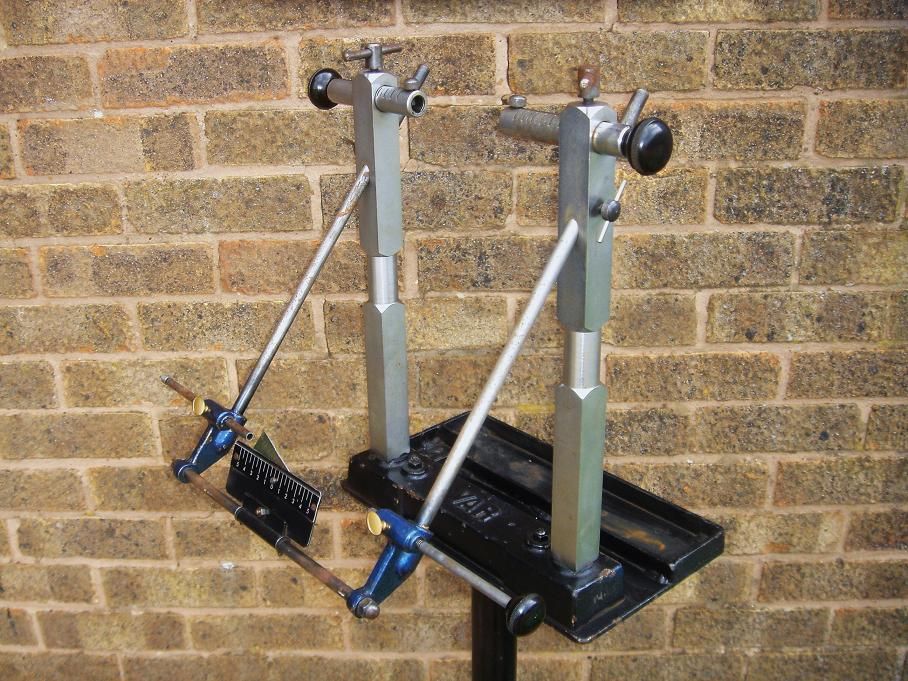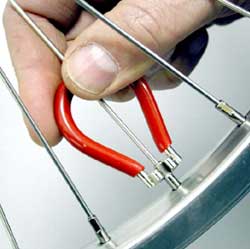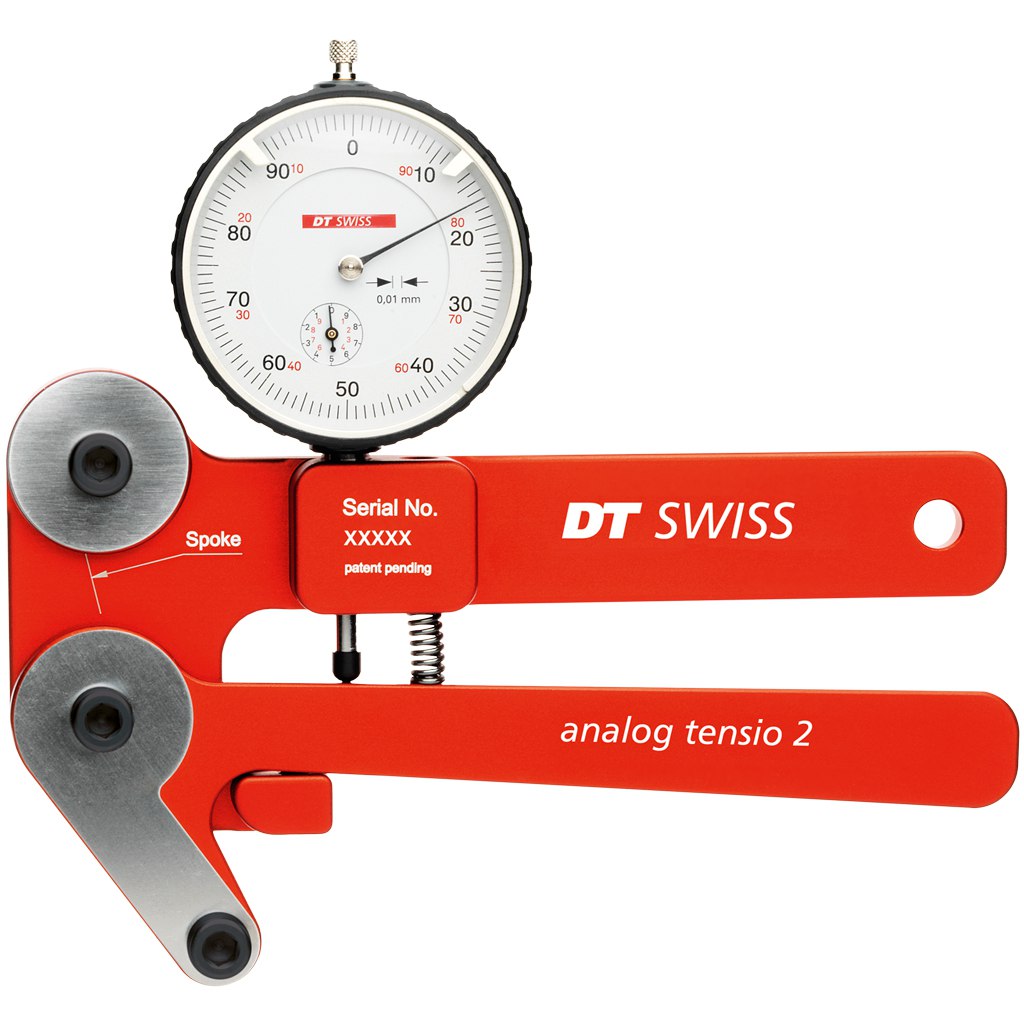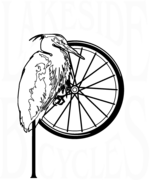Wheel Truing Basics:
 |
How To True Wheels
Solve Your Wheel Woes With This Important Skill |
Bicycle wheels have come a long way since the days of wooden spokes and metal tires in the early 1800s when two-wheelers first appeared (bicycle wheels have come a long way since 1997). Today’s hoops, whether made for the rigors of trail riding or for the thrill of carving blacktop, are so light they’re nearly effortless to pedal and so strong, they hold up for years. What’s more, in the case of standard wire-spoke models, the type found on most modern bikes, today’s wheels are much easier to fix should something go wrong. That’s what this article is about.
Understanding basic wheel repair enables you to keep your rig riding smoothly, efficiently and stopping effectively.
First of all: Leave The Superwheels To Us
There are a wide variety of wheels available today and some are easier to true than others. Here, we offer basic wheel-truing instructions applicable to all wire-spoke wheels. If you have a high-tech racing wheelset from the likes of Mavic, Campagnolo or ENVE, one with very few spokes and/or hidden nipples, we recommend bringing it into the shop for repairs, or at least calling (503-699-8665) for advice (which will almost be "please bring the wheel in"). These wheels are specially built by the manufacturer and usually require unique tools and techniques (for example, some have locked nipples). You can rapidly reduce a slightly unsatisfactory wheel to junk if you try working on these types of wheels without proper tools or training.
Truing Tools
A spoke wrench is the only tool required for truing (the term for straightening a wheel). This is a small wrench that grips the spoke nipples and lets you tighten or loosen the spokes to align the wheel  (photo). More about that in a minute. Nipples and wrenches come in different sizes so be sure to get a wrench that fits your wheels. Ride in or bring a wheel in and we can pick out the right tool for you.
(photo). More about that in a minute. Nipples and wrenches come in different sizes so be sure to get a wrench that fits your wheels. Ride in or bring a wheel in and we can pick out the right tool for you.
To fix wheels, our professional mechanics use a device called a truing stand (see top photo) that supports the wheel and makes it easier to see imperfections. You can do the job just fine by leaving the wheel in place and using your bike as a stand. Just suspend the bike so that the wobbler is at about chest level. And be sure to move a good light next to the bike so you can see what you’re doing.
Typical Wheel Problems
Under normal use, wheels remain true because the spokes are evenly tensioned to keep the rim aligned. Subjected to rough roads/trails, bumps and jumps, however, spokes may loosen, and when this happens, wheels can develop side-to-side wobbles. This is called a “warp,” as in, “my wheel is warped,” and is something you’ll be able to repair following our instructions and with a little practice.
It’s important to understand that it’s also possible to bend wheels. This is usually the result of a serious impact from slamming into a hole or crashing. If you suffer this type of damage, truing the wheel probably won’t work because it’s become structurally unsound (the rim is crooked). You can recognize serious wheel damage by dents and/or bulges in the rim and significant defects in roundness and/or lateral alignment. In most cases, this type of damage requires rim or wheel replacement. So you should bring your wheel in to us for an estimate.
Getting Oriented
With your bike suspended and the wheel needing help in easy view, look closely at how the spokes leave the hub. Notice that there are spokes on the right and left sides of the hub. You can usually notice that the spokes are offset to the left and right at the rim too (photo; rim only shown so you can see the offset). The key to truing is adjusting the spoke(s) on the correct side of the wheel.
notice that the spokes are offset to the left and right at the rim too (photo; rim only shown so you can see the offset). The key to truing is adjusting the spoke(s) on the correct side of the wheel.
Note that the spokes have nut-like devices at the rim called nipples. When viewed from above, nipples are turned clockwise with the spoke wrench to tighten spoke tension and counterclockwise to loosen it. To ensure that you turn the nipple the correct way, always rotate the wheel to bring the nipple to the top first.
Also, when truing, it’s best to turn nipples no more than ½ turn at a time, check your progress to see how you’re doing, and repeat as necessary.
Locating The Wobble
Usually, the easy way to find the problem area (the loose spoke) is to spin the wheel and watch for the wobble by watching the gap between the rim and one brake pad. When you see the wheel wobble to one side you’ve located the problem spot. (You can also rest a thumb against the brake pad as the wheel spins to feel for the wobble.)
When you find the bad spot, stop the wheel and wiggle the spokes in this area to feel for ones that are significantly looser than their neighbors. You’ll probably discover that if the wheel is warped to the right, a spoke or two on the left side will feel looser. The opposite will be true for wobbles to the left.
You can also find wobbles/problems by starting at the valve stem and going around the wheel wiggling each spoke in your fingers feeling for loose ones. On a good wheel the spokes will feel evenly tensioned (note that on rear wheels, by design, the left-side spokes are not as tight as the right ones; what’s important is that the spokes on each side are evenly tensioned compared to each other).
Truing
Truing the wheel is just a matter of turning the right nipples just the right amount to tighten the loose spokes until they’re as tight as the other spokes on that side of the wheel. A simple way to keep track of the spokes that you’re tensioning is putting a piece of tape on them. That way, you won’t lose track of them when you spin the wheel to check how the wheel is improving.
Remember to turn the spokes in small increments and spin the wheel to check your progress. After a few adjustments, you should find that the wheel is nice and true again. The most common mistakes are turning nipples the wrong direction or turning the wrong nipple. So, remember to double-check that the spoke you're adjusting is on the correct side of the wheel and that you always bring its nipple to the top of the wheel and turn clockwise.
Truing By Pitch If you’re musically inclined, you might prefer another truing technique involving plucking the spokes with your finger and listening to the noise they make. You’ll find that the loose spokes sound “dead.” If you tighten them until they make the same sound as their neighbors, you’ll quickly straighten the wheel. Note: While the wheel builders at Lakeside Bicycles can build and true wheels by pitch, they are experts with years and hundreds of wheels under their belts. If you are seriously thinking of working on someone else's wheels and this article is as far as your studies have taken you, get a tension meter: they are placing their lives in your hands and you owe it to them not to take foolish risks.
If you’re musically inclined, you might prefer another truing technique involving plucking the spokes with your finger and listening to the noise they make. You’ll find that the loose spokes sound “dead.” If you tighten them until they make the same sound as their neighbors, you’ll quickly straighten the wheel. Note: While the wheel builders at Lakeside Bicycles can build and true wheels by pitch, they are experts with years and hundreds of wheels under their belts. If you are seriously thinking of working on someone else's wheels and this article is as far as your studies have taken you, get a tension meter: they are placing their lives in your hands and you owe it to them not to take foolish risks.
The wheel does not have to be perfectly round or true; slight runouts are barely acceptable (a millimeter or two) when working on your own wheels. As long as there are no loose spokes and the wheel is reasonably straight (the rim and tire mustn't rub on the brake pads), it will ride nicely and hold up fine.
Note: these instructions are for basic wheel repairs, however, it can be very satisfying to fix a wobbly wheel and it can make you a big hit with your friends if you can get their wheel round enough for them to keep riding when you’re out on the road or trail. If you have any questions, we’re happy to advise. And, if you have more serious wheel problems, our wheelsmiths can help. The first two photos are courtesy of Park Tool.
